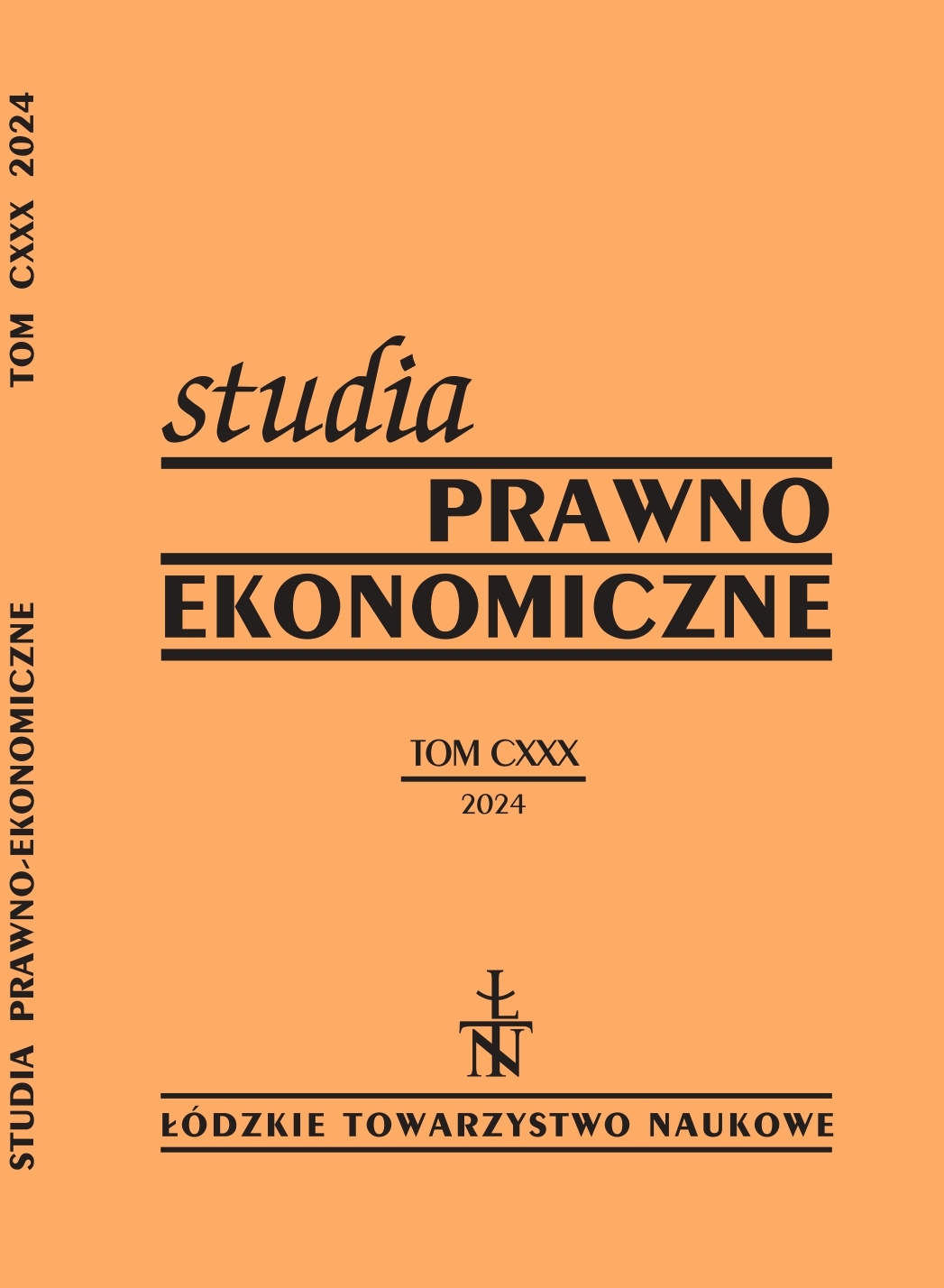The impact of legislative regulation on VAT revenues in Poland: An empirical analysis 2005–2022
DOI:
https://doi.org/10.26485/SPE/2024/130/5Keywords:
VAT revenues, VAT gap, structural change, econometric model, smooth transition model.Abstract
Background: The increase in the share of VAT revenues in gross domestic product after 2015 has triggered a discussion about its causes and how the increased tax revenue stream can be sustained. A feature of this discussion is the lack of consensus regarding the role played by regulatory and legal factors in fluctuations in the VAT gap and the cyclical nature of tax revenues. Processes further complicating the assessment of the effectiveness of regulations sealing VAT collection are the COVID-19 pandemic and the outbreak of war in Ukraine.
Research purpose: The main objective of the article is the empirical identification of the mechanisms dominating the formation of VAT revenue in Poland in the period 2005–2022. According to the main research hypothesis, fluctuations in VAT revenue were determined not only by changes in the tax base and cyclical fluctuations, but also by legal regulations sealing the VAT collection system. The aim of the article is achieved by verifying a sequence of partial research hypotheses that allow us to determine the nature and scale of the impact on VAT revenue of their potential determinants. According to the most important partial research hypothesis, legal regulations introduced in 2016–2018 played a primary role in closing the VAT gap.
Methods: Econometric techniques were used to verify the research hypotheses. The answer to the question of the existence of a stable equilibrium relationship between VAT revenues, tax base and cyclicality indicators in the Polish economy was obtained using the cointegrated vector autoregressive model C-VAR. The hypothesis on the occurrence of a structural change induced by the introduction of sealing regulations was verified using the autoregressive smooth transition model STR.
Conclusions: The results of the research confirm the staggered, increasing impact of sealing regulations on the level of government VAT revenues. The hypothesis of a permanent effect of regulations on the behaviour of economic agents is positively verified. The results of the verification of the hypothesis on the impact of cyclical fluctuations on VAT revenues turn out to be inconclusive.
Downloads
References
Allingham M.G., Sandmo A., Income Tax Evasion: A Theoretical Analysis, Journal of Public Economics 1972/1, s. 323–380.
Andreoni J., Erard B., Feinstein J., Tax Compliance, Journal of Economic Literature 1998/36, s. 818–860.
Bratkowski A., Kotecki L., Luka VAT w świetle analiz makroekonomicznych, Instytut Obywatelski, Warszawa 2018, https://instytutobywatelski.pl/pliki/pdf/Luka-VAT-w-swietle-analiz¬-makroekonomicznych.pdf; stan na 12.07.2023 r.
Bruzda J., Procesy nieliniowe i zależności długookresowe w ekonomii. Analiza kointegracji nieliniowej, Wydawnictwo Naukowe Uniwersytetu Mikołaja Kopernika, Toruń 2007.
EC, Study and Reports on the VAT Gap in the EU-28 Member States: Report 2018, Publications Office of the European Union 2018, https://taxation-customs.ec.europa.eu/system/ files/2018-10/2018_vat_gap_report_en.pdf; stan na 12.07.2023 r.
EC, VAT gap in the EU: Report 2021, Publications Office of the European Union 2021, https:// data.europa.eu/doi/10.2778/447556; stan na 12.07.2023 r.
EC, VAT Gap in the EU: Report 2022, Publications Office of the European Union 2022, https:// op.europa.eu/en/publication-detail/-/publication/030df522-7452-11ed-9887-01aa75ed71a1; stan na 12.07.2023 r.
Granger C.W.J., Teräsvirta T., Modeling Nonlinear Economic Relationships, Oxford University Press, New York 1993.
Hutton E., The Revenue Administration – Gap Analysis Program: Model and Methodology for Value-Added Tax Gap Estimation, Technical Notes and Manuals 17/04, IMF, Washington 2017.
Johansen S., Likelihood-Based Inference in Cointegrated Vector Autoregressive Models, Oxford University Press, Oxford 1995.
Juselius K., The Cointegrated VAR Model, Oxford University Press, Oxford 2006.
Kelm R., Determinants of the VAT Gap in EU Member States from 2000 to 2016, Central European Journal of Economic Modelling and Econometrics 2022/14, s. 225–262.
Konopczak K., Kwantyfikacja zmian luki VAT: podejście ekonometryczne, Gospodarka Narodowa 2020/2 (302), s. 25–42.
Konopczak K., Zmiany luki VAT w Polsce: rola czynników koniunkturalnych i strukturalnych, Gospodarka Narodowa 2022/1 (309), s. 44–65.
Kotlińska J., Podatek od towarów i usług i jego ściągalność w Polsce, Ekonomista 2018/5, s. 595–617.
Majsterek M., Wielorównaniowa analiza kointegracyjna w ekonomii, Wydawnictwo Uniwersytetu Łódzkiego, Łódź 2008.
Mazur T., Bach D., Juźwik A., Czechowicz I., Bieńkowska J., Raport na temat wielkości luki podatkowej w podatku VAT w Polsce w latach 2004–2017, MF Opracowania i Analizy 2019/3, Ministerstwo Finansów, Warszawa.
Pesaran H.M., Timmermann A., Selection of Estimation Window in the Presence of Breaks, Journal of Econometrics 2007/137, s. 495–510.
PIE, Zmniejszenie luki VAT w Polsce w latach 2016–2017, Polski Instytut Ekonomiczny, Warszawa 2018, https://pie.net.pl/wp-content/uploads/2019/01/Raport-LUKA-VAT.pdf; stan na 12.07.2023 r.
Tax Gap Project Group, The Concept of Tax Gaps, Report on VAT Gap Estimations: Fiscalis Tax Gap Project Group (2016/FPG/041), European Commission, https://taxation-customs. ec.europa.eu/system/files/2016-09/tgpg_report_en.pdf; stan na 12.07.2023 r.
Teräsvirta T., Specification, estimation, and evaluation of smooth transition autoregressive models, Journal of the American Statistical Association 1994/89, s. 208–218.
Tratkiewicz T., Luka w VAT – sposoby przeciwdziałania w Polsce i Unii Europejskiej, Studia Ekonomiczne. Zeszyty Naukowe Uniwersytetu Ekonomicznego w Katowicach 2016/294, s. 185–196.
Tratkiewicz T., Podatek od towarów i usług jako narzędzie polityki fiskalnej w latach 2004–2013, Studia Ekonomiczne 2014/198, s. 307–322.
Downloads
Published
How to Cite
Issue
Section
License
Copyright (c) 2024 Łódzkie Towarzystwo Naukowe

This work is licensed under a Creative Commons Attribution-NonCommercial-NoDerivatives 4.0 International License.



